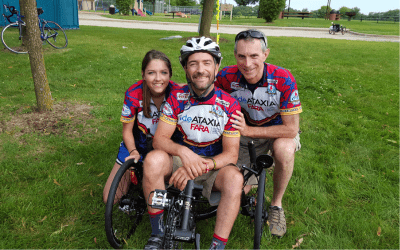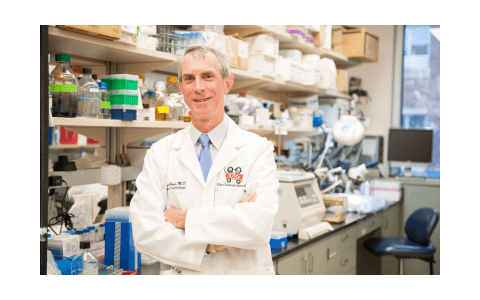In 1863, German physician Nikolaus Friedreich first described a degenerative nervous system condition that would later be named in his honor. Friedreich's ataxia is a rare genetic disorder resulting in various life-altering symptoms including muscle weakness, loss of senses and coordination, heart problems and diabetes. More than 160 years after the condition was discovered there is still no cure, but promising treatments are on the horizon including one developed by an Indiana University School of Medicine physician-scientist driven by innovation and a collaborative spirit.
Uncovering the path to progress
R. Mark Payne, MD, is a professor of pediatrics at IU School of Medicine and a pediatric cardiologist at Riley Children’s Health. During his postdoctoral training at the Washington University School of Medicine in St. Louis, the lab he worked with was involved in mitochondria research and it became his research interest as well.
“My research revolved around how mitochondria make energy and regulate the cell,” Payne said. “As part of this, I studied how proteins get imported into mitochondria, which later became the key to my connection with Friedreich’s ataxia.”
Following his training, after several years centered in a clinical setting, Payne was drawn back to research. A chance encounter in 2001 with a colleague in an airport led to a conversation about Friedreich’s ataxia, a condition Payne did not know much about at the time. However, it immediately piqued his interest after learning it was caused by the mitochondria—a subject he knew very well.
Although it’s rare, affecting about one in every 50,000 individuals in the United States, Friedreich's ataxia is the most common form of hereditary ataxia. The disease is caused by a gene mutation that results in the loss of a key protein called frataxin found in a cell’s mitochondria. Friedreich's ataxia is typically diagnosed in early childhood through adolescence, with many patients eventually losing neurologic capabilities like walking or talking. They also develop a severe cardiomyopathy, which can lead to their death. Individuals with the disease have an average life expectancy that’s only in the mid-thirties.
After learning about Friedreich's ataxia’s cause, Payne asked himself, “What will happen if I modify and make the protein in the lab and then inject it into models with the disease?”
As Payne’s hypothesis for a treatment that could deliver therapeutics straight to the mitochondria began to take shape, he connected with a nonprofit research and patient advocacy group called Friedreich’s Ataxia Research Alliance (FARA) to join their research support network. Established in 1998 by patients affected by the disease, FARA has remained committed to supporting and partnering with scientists worldwide, exemplified through a generous grant program.
“FARA’s always been a collaboration between people affected with or living with the disease and the scientific community working together toward this common goal of finding treatments,” said FARA’s Chief Executive Officer Jennifer Farmer, MS. “Dr. Payne was an early scientist to submit a grant asking us to fund some of his research.”
 In 2003, FARA helped Payne obtain mice missing the frataxin protein so his laboratory could begin running tests, and the organization continues to partner with him to this day. Farmer said Payne’s interest in developing therapies for Friedreich’s ataxia, combined with his background as a respected clinician and cardiologist, resulted in FARA’s ongoing partnership and his appointment to the organization’s scientific advisory board more than a decade ago.
In 2003, FARA helped Payne obtain mice missing the frataxin protein so his laboratory could begin running tests, and the organization continues to partner with him to this day. Farmer said Payne’s interest in developing therapies for Friedreich’s ataxia, combined with his background as a respected clinician and cardiologist, resulted in FARA’s ongoing partnership and his appointment to the organization’s scientific advisory board more than a decade ago.
“He knows the academic science really well, how to be a good physician, and how to be a good researcher,” Farmer said. “When it came to starting a company and raising money, it was helpful for him to have connections to people on our board who would be able to help him do that. We were happy to help him gain that momentum.”
The Payne lab’s early tests in mice showed successful results, so Payne published findings from his work and filed a patent for the drug he invented and later named CTI-1601. Around this time in 2005, with encouragement from his Hoosier colleagues Loren Field, PhD, and Richard Schreiner, MD, Payne transitioned from Wake Forest University in North Carolina to the IU School of Medicine. Moving and growing his lab at the Herman B Wells Center for Pediatric Research provided Payne more time to dedicate to research and development, an arrangement he believes is often difficult for many physician-scientists to explore.
“I’m grateful to the Wells Center and IU for giving me the time to focus on the translational research needed to develop this concept in the lab, and the challenges of raising funds for CTI-1601,” Payne said. “The support I’ve received has helped advance the drug to the point of clinical trials and becoming a commercial reality, a milestone that very few physicians have been able to reach.”
Navigating the road to the marketplace
Recognizing there were no drugs in the marketplace that could deliver therapeutics into the mitochondria for the treatment of mitochondrial diseases, in 2012 Payne established a small biotechnology company called Chondrial Therapeutics, LLC, to kick off the process of bringing CTI-1601 to patients. With help from co-founder Steven Plump, the startup company fostered investor relationships and raised essential funds to get the drug manufactured so Payne could continue investigating the treatment’s results.
“When we began to develop the company, we successfully obtained a Therapeutics for Rare and Neglected Diseases program grant from the National Center for Advancing Translational Sciences,” Payne said. “That’s a special award that only about 5% of applications secure, and the program helped me tremendously move ahead in obtaining adequate funding in a consistent and steady pattern.”
After receiving valuable grants and multi-millions of investment dollars, and consistently exhibiting effective study results, Chondrial Therapeutics and CTI-1601 were acquired by a venture capital firm that in 2018 was rebranded as Larimar Therapeutics, Inc.
In February 2024, Larimar Therapeutics announced positive results from the drug’s Phase 2 clinical trial, showing the treatment reached levels that are predicted to be therapeutic in individuals with Friedreich’s ataxia. The significant milestone has resulted in a longer-term Phase 2 study that is now underway and another trial has begun using a lower dose of the drug to show its long-term safety effects in patients. These pivotal steps are all integral to advancing the drug toward potential approval by the U.S. Food and Drug Administration (FDA).
Inspiring hope and breakthroughs ahead
CTI-1601’s current journey through the FDA approval process reflects two decades of dedicated effort and collaboration. Alongside fundraising challenges, Payne recalls an arduous yet imperative patent approval process. However, one of the most unexpected challenges he faced was recognizing that his strengths lie in clinical and laboratory work while his industry partners excel in navigating the business world. Payne acknowledges the pharmaceutical industry is structured with this dynamic in mind and advises aspiring scientific entrepreneurs to forge strong partnerships and have faith in the process.“My advice for scientists moving their inventions forward is to find people who you can really talk with that believe in what you're doing,” Payne said. “I've learned from this process that at some point you have to let go of your invention and let other people take it over and you have to get out of the way.”
 While the success of CTI-1601 remains a top priority for Payne, he’s actively involved in several other important research projects focused on understanding and treating cardiomyopathies and heart failure in children. As part of the cardiac developmental biology research programs at both the Wells Center and the Krannert Cardiovascular Research Center, Payne works with several talented scientists including professor of pediatrics Weinian Shou, PhD.
While the success of CTI-1601 remains a top priority for Payne, he’s actively involved in several other important research projects focused on understanding and treating cardiomyopathies and heart failure in children. As part of the cardiac developmental biology research programs at both the Wells Center and the Krannert Cardiovascular Research Center, Payne works with several talented scientists including professor of pediatrics Weinian Shou, PhD.Payne and Shou have worked together for more than a decade and have even teamed up on a new venture aimed at treating Friedreich’s ataxia. They are collaborating on a different therapeutic that will use a combination of an engineered frataxin gene with a specific cardiac protein to target both nerve and heart complications in people with the disease. Shou believes Payne’s innovative and collaborative spirit sets a good example of breaking down barriers between physicians and scientists.
“Dr. Payne is a world-leading physician-scientist in Friedreich’s ataxia research and treatment. It is amazing to see him working tirelessly and so determined on this difficult disease throughout his medical and science career,” Shou said. “He is always open-minded to embrace new technologies and willing to apply them to the research. It’s an honor to be his colleague and collaborator.”
Like Shou, Jennifer Farmer also believes Payne’s determination, and more importantly his humility, set him apart in the field.
“He discovered this treatment that's now in advanced clinical trials that people are really excited about, but he also shows up,” Farmer said. “He volunteers a ton of his time for FARA reviewing grants for us and giving us scientific advice. He attends meetings and educational events with patients to talk about the cardiomyopathy of the disease and how they can take better care of their hearts. It’s all very much appreciated.”
Despite his demanding schedule and the complex nature of bringing novel therapies from discovery to the market, Payne believes a profoundly worthy purpose drives every breakthrough. As a Riley Children’s pediatric cardiologist, he treats many young patients in Indiana including those affected by Friedreich’s ataxia. These interactions serve as a source of inspiration, complemented by the enduring support he has received from countless individuals throughout his entrepreneurial journey.
“By the time the drug gets into actual clinical use, another treatment may pop up,” Payne said. “But just to be able to tell patients what we’re working on offers them hope and reminds them that they’re not alone. Somebody’s actually trying to help them, and that person has had an incredible community of support behind him along the way.”
